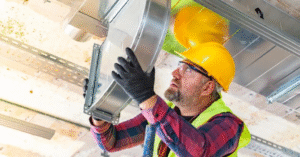Roof Repairs Made Simple: How to Identify Damage and Work with Skilled Roofers
Your roof is similar to a good pair of boots, you don’t even notice it when it’s performing, but the instant there is a gap, you do. And while with boots you can simply chuck it in the trash and replace it, you can’t with your roof. Roof maintenance is a reality for all homeowners, and identifying problems early can keep you out of bigger hassles (and expenses) in the future.
This handbook deconstructs how to identify roof damage before it becomes a leak you can hear at night, along with how to select competent roofers who understand what they’re doing.

Why Early Detection Saves More Than Money
Roof problems rarely announce themselves with flashing lights and sirens. Often, they start small — a cracked tile here, a bit of rust there — and quietly grow into costly repairs. Think of it like termites: by the time you see the obvious signs, a lot of damage has already been done.
Early detection:
- Prevents water damage to ceilings, insulation, and walls
- Stops mould growth (which loves hidden damp spots)
- Protects the structural timber in your roof space
- Keeps repair costs manageable
Even small leaks can create a chain reaction of issues. That slow drip you notice in the corner of the ceiling? It could already be spreading moisture through half the roof cavity.
Common Signs Your Roof May Need Attention
You don’t need to go up on your roof to realize something’s amiss. Most warning signs can be seen from the ground or from inside your house.
- Water marks on ceilings or walls – Typically brownish circles that show previous or current leaking.
- Missing or broken tiles – A single gap is enough to allow water to enter.
- Rust on metal roofing – Particularly around screws, joints, or roof valleys.
- Sagging roof lines – May indicate structural problems in the roof structure.
- Blocked downpipes and gutters – Overflowing water can seep under the edge of the roof.
- Loose flashing – These metal strips prevent water from entering weak joints; when they rise, leaks ensue.
Pro tip: Inspect from the ground using binoculars for visible problems. If you must climb, call someone else — roof falls are much too frequent in DIY efforts.
Why Gosford Roofs Have Their Own Set of Problems
Other suburbs, other roofing dilemmas. Houses in Gosford, for instance, struggle with a combination of sea air and bushland exposure. Roofs get to suffer salt spray one week and leaf litter the next. Salt speeds up corrosion in metal roofs, while leaves hold water against tiles and gutters.
Conversely, a city like Parramatta, more interior, experiences reduced salt damage but increased dust and thermal expansion from warmer summer days. Repairing roofs in Gosford tends to involve replacing rusted sheets or repairing gutter systems clogged by a mix of salt-grit and organic matter.
And then there are heritage-strong suburbs such as Balmain, where repairs can be delayed by building regulations, or wind areas such as Newcastle that experience more storm damage. A quality roofer would know these location-specific idiosyncrasies.
The Smart Way to Choose the Right Roofer
Finding the right tradesperson isn’t about the cheapest quote — it’s about the right skills for your home’s roof type and the conditions it faces.
Here’s what to look for:
- Local experience – Roofers in Gosford, for example, will have firsthand knowledge of coastal wear and tear.
- Specialisation – Tiled roofs, metal roofs, slate, or heritage styles all require different expertise.
- Transparent quoting – A clear breakdown of costs beats a vague one-liner any day.
- Insurance and licensing – Protects you if something goes wrong on-site.
- References and reviews – Not the cherry-picked ones; look for consistent patterns in feedback.
Avoid rushing. Even if water is dripping into a bucket in your lounge room, take the time to check credentials and past work.
DIY Repairs: Where to Draw the Line
We’ve all seen the neighbour with a ladder, a hammer, and a mysterious bundle of materials on the roof. Sometimes it works out fine. Other times, it’s a trip to the emergency room and a half-finished repair that now costs more for a professional to fix.
Safe DIY: Clearing gutters, trimming overhanging branches, checking for obvious damage from the ground.
Leave it to the pros: Anything involving structural repairs, replacing sheets or tiles, or working near the roof edge. Even cleaning certain types of roofs can be risky if you’re not using the right equipment.
Roofing is one of those trades where small mistakes can have big consequences — water takes the path of least resistance, and a poorly placed screw or misaligned tile can create new leaks.
Maintenance Habits That Add Years to Your Roof’s Life
A little maintenance can push major repairs far into the future. Here’s a simple schedule:
- Every 6 months: Clear gutters, check for visible damage, remove debris from valleys.
- Annually: Have a roofer inspect high-risk areas like flashing, ridge capping, and skylights.
- After major storms: Check for loose tiles, dislodged sheets, or bent gutters.
If you live under large gum trees, you might need to do gutter cleaning more often. Leaf litter holds moisture, which can speed up corrosion or rot.
Case Study: From Small Leak to Major Repair
A Gosford family recently saw a slight watermark on their ceiling. They thought that it was an old spot and dismissed it. During the next few months, it darkened. By the time they had a roofer repair it, the water had softened the roof trusses in the area, which necessitated not only a repair but partial rebuild.
If they had moved when the mark first came in, the repair would have cost a few hundred dollars. The bill in the end? More like $8,000.
Moral of the story: roofs do not heal themselves. The sooner you repair, the better it will be.
Questions to Ask Before Agreeing to Any Repair
- What’s causing the damage — and how can I prevent it happening again?
- Will the repair blend in with the existing roof, or will it be obvious?
- How long should I expect this fix to last?
- What’s covered under your workmanship warranty?
- Do you take photos before and after the repair?
Good roofers appreciate informed customers. These questions help you understand what you’re paying for and avoid repeat issues.
Final Thoughts
Roofs don’t require much, a little care here and there. Either you’re in Gosford coping with salt and storms, or inland coping with heat and dust, having an eye out for the signs of damage and the right expert on speed dial is your best protection.
Don’t wait for the bucket in the lounge room episode. Catching it early today might just save you money tomorrow.










Post Comment